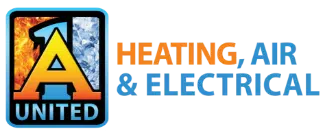Is your home feeling chilly despite your furnace running? Low heat from your furnace is one of the most common furnace problems homeowners face during winter months. There are several potential causes for this issue, including a clogged air filter, faulty thermostat or leaky ductwork.
If you’re experiencing inadequate heating, it’s crucial to know the difference between something you can fix on your own and something more serious that requires professional furnace repair to ensure your system operates efficiently and keeps your home comfortably warm.
Here are signs of some common furnace problems and how to know when they need repair from an expert like the team at A-1 United.
1. Clogged or Dirty Air Filter
A clogged or dirty furnace air filter can significantly impair your furnace’s performance and efficiency. When the filter becomes excessively dirty, it blocks airflow, forcing your furnace to work harder to circulate warm air throughout your home. In addition to causing unnecessary strain on your furnace, a blocked filter can lead to increased energy consumption and potential system overheating.
Check your furnace air filter monthly. How often you should replace your air filters depends on a number of factors, such as climate, pets, or the age of your system. Explore our online shop to find the best air filter option for your home.
2. Thermostat Issues
If you’re experiencing inconsistent heating or cooling in your home, it could be a problem with your thermostat. A malfunctioning thermostat may fail to accurately read room temperatures or communicate properly with your furnace, leading to inefficient operation and potentially higher energy bills. An improperly calibrated or outdated thermostat can also cause temperature fluctuations, or it could mean your thermostat is not on heat mode or the batteries in your thermostat are dead and need replacement.
If your home is having these issues, check to see if the thermostat is in the right mode, is giving accurate readings, and has fresh, working batteries.
3. Blocked or Leaky Ductwork
Another reason your furnace isn’t blowing warm air in some rooms could be that you have blocked or leaky ductwork. When your home’s ducts are blocked or have gaps, warm air can escape into unused areas like attics or crawl spaces. This can cause uneven heating and force your furnace to work harder, which can lead to increased energy consumption and potential system strain.
If you suspect a ductwork problem, it’s recommended to call a professional for evaluation.
4. Pilot Light or Ignition Problems
These problems can stem from various causes, including dirty pilot orifices, faulty thermocouples, drafts, gas supply issues or malfunctioning electronic ignition components, all of which can disrupt the crucial first step in your furnace’s ignition.
While many homeowners do light their own furnace pilot light — the directions are often attached to a sticker on the outside of the furnace — if you feel uncomfortable, call A-1 United. We also can evaluate your system for any possible ignition problems.
5. Malfunctioning Blower Motor
Signs of a bad furnace blower motor are unusual noises like squealing, rattling or banging when the heat is on, or you also may notice weak or no airflow coming from the vents in your home. Other signs are that your energy bills increase unexpectedly, or you notice a burning smell coming from the vents.
A malfunctioning blower motor is not a DIY fix. If you suspect this is the issue, call our team for furnace repair.
6. Gas Supply or Burner Issues
One of the common gas furnace problems is an issue with the gas supply. The easiest way to check this is to look for the gas shut-off valve near your furnace to see if it is fully open. If it is, check to see if other gas appliances in your home are working. If they aren’t, you should contact a professional HVAC technician to investigate.
Signs of a dirty or corroded furnace burner include a yellow or orange flame instead of blue, and unusual noises like bangs or pops when the furnace ignites. This can lead to no heat, incomplete combustion, reduced heating efficiency and potentially dangerous carbon monoxide leaks — making it crucial for a pro to address burner issues promptly.
If you ever smell gas, suspect a gas leak or are experiencing signs of carbon monoxide poisoning, immediately get everyone outside the building and to a safe place. Then, contact emergency services and an HVAC professional to investigate.
7. Lack of Regular Maintenance
Increased energy bills, reduced heating efficiency and frequent breakdowns are all signs it’s time to schedule furnace maintenance. You may also notice a buildup of dust and debris around the unit, unusual noises during operation or inconsistent heating throughout your home.
When you call A-1 United for residential or commercial maintenance, we’ll give your furnace a detailed examination to look for signs of wear and tear. We’ll make any necessary adjustments, check electrical connections and even check your filters so your furnace is ready to roll.
When to Call a Professional for Furnace Repairs
When faced with complex furnace problems like a faulty blower motor, gas supply problems, ignition failures or burner malfunctions, it’s crucial to call a professional HVAC technician for proper diagnosis and repair. These issues can be dangerous if not addressed correctly and may lead to more extensive damage or safety hazards if attempted as DIY repairs.
The qualified professionals at A-1 United have expertise, tools and knowledge to safely and effectively resolve all common furnace problems — so your heating system operates efficiently and safely. And, if it’s time to upgrade, ask us about furnace installation. We proudly install quality equipment from Lennox, including the extremely energy-efficient Lennox Signature Collection, and will find the ideal match for your home.
Don’t risk your comfort or safety! Call or text A-1 United at 402-593-7500 today for expert furnace repair.
